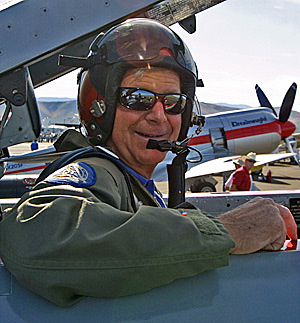By Clayton Moore
The air racing community was shocked last month to lose one of its most beloved members. Air show pilot Art Vance, a true icon of the Reno National Champion Air Races and Air Show, was killed on October 8, not in a fast and furious race but during a quiet transport run from Tennessee to Arkansas.
Vance was flying a 1944 Grumman F6F Hellcat on behalf of the Planes of Fame Museum in Chino, Calif., an organization for which he had volunteered for many years. The veteran warbird pilot was attempting an emergency landing in an elevated, rocky area near Monterey, Tenn., when his aircraft went down.
“It was like a movie to see that plane suddenly appear,” said witness Jim Winters, who saw the plane try to come down near the median of Interstate 40.
According to other eyewitnesses, the plane crashed and then caught fire. No one else was in the aircraft and no others were injured by the accident, but the plane did leak fuel onto the interstate, which was backed up with fans leaving the University of Tennessee football game in Knoxville.
Vance, from Sebastopol, Calif., had logged over 11,000 hours as an airline pilot and had over 1,200 hours of propeller fighter time. He first competed at the Reno Air Races in 1984 and was a fixture at the races for the next 20 years. He flew the pace plane for all the Unlimited Class races in September.
His appearances were sure to draw a crowd. He was most closely associated with his North American P-51D Mustang, which he bought in 1976. It was rebuilt in 1982 as “Million Dollar Baby” and renamed “Speedball Alice” in 2000. He had also raced a stock Hawker Sea Fury, “Baby Gorilla,” and most recently, “Furias,” another Sea Fury, from 2000 to 2002. He made his best time in the Sea Fury in 2002, flying to a personal record of 415 mph. Vance was president of the Unlimited Class at Reno as well.
In recent years, he had become the voice of reason at Reno, teaching aircraft and race safety as an instructor and serving as a check pilot for Reno’s Pylon Racing Seminar. His deadpan sense of humor was a welcome addition to “New Guy School,” according to students.
“You feel pretty good sitting there going 400 mph,” Vance would say to the rookies. “Let me tell you, when another racer passes you on the outside at 500 mph, it’s a whole different ball game.”
He provided a lively approach to the serious business of guiding new pilots into the races. The school, developed after a number of accidents and close calls at Reno, aims to make sure new pilots stay safe and perform up to standards.
“You’re a success at Reno, if number one, you don’t kill anybody; number two, you don’t kill yourself; number three, you don’t hurt yourself; and number four, you don’t bend up the airplane,” Vance said. He often related that he felt a responsibility not only to the rookies but to all of his fellow pilots at Reno.
“We’re not throwing rocks at guys that have handled things poorly in the past,” Vance said. “We’re giving information to the new guys and allowing them to consider the events before it happens to them.”
He often flew with his son, Dan, who flew at Reno in September as the new pilot of #911, “September Pops,” a Hawker Sea Fury. Dan wound up taking 7th place in the Unlimited Class gold race with a speed of 400.1 mph. Father and son also restored several vintage airplanes including a Vultee BT-13B Valiant and a T-6. Art Vance also leaves behind his wife Judy and his daughters Debbie and Sharon.
Vance was flying the Hellcat from Sevierville, Tenn., to an air show in Little Rock, Ark., when the accident occurred. It was one of 150 aircraft at the Planes of Fame Museum in Chino and was one of the first in the collection, according to Mark Foster, the museum’s vice president.
“Art’s passing is a huge loss to the air racing community,” said Reno Air Racing Association spokeswoman Valerie Enos. “Our event will not be the same without him flying overhead during the Unlimited races, briefing the class, mentoring new race pilots, and providing priceless counsel to all of us within the sport. He provided the steady hands on the stick and throttle of the Unlimited Class that guided its safe participation and growth here in Reno.”












